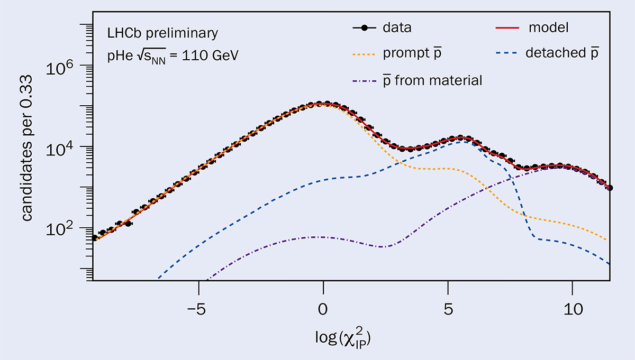A report from the LHCb experiment.

During their 10 million-year-long journey through the Milky Way, high-energy cosmic rays can collide with particles in the interstellar medium, the ultra-rarefied gas filling our galaxy and mostly composed of hydrogen and helium. Such rare encounters are believed to produce most of the small number of antiprotons, about one per 10,000 protons, that are observed in high-energy cosmic rays. But this cosmic antimatter could also originate from unconventional sources, such as dark-matter annihilation, motivating detailed investigations of antiparticles in space. This effort is currently led by the AMS-02 experiment on the International Space Station, which has reported results with unprecedented accuracy.
The interpretation of these precise cosmic antiproton data calls for a better understanding of the antiproton production mechanism in proton-gas collisions. Here, experiments at accelerators come to the rescue. The LHCb experiment has the unique capability of injecting gas into the vacuum of the LHC accelerator. By injecting helium, cosmic collisions are replicated in the detector and their products can be studied in detail. LHCb already provided a first key input into the understanding of cosmic antimatter by measuring the amount of antiprotons produced at the proton–helium collision vertex itself. In a new study, this measurement has been extended by including the significant fraction (about one third) of antiprotons resulting from the decays of antihyperons such as Λ, which contain a strange antiquark also produced in the collisions.
These antiprotons are displaced from the collision point in the detector, as the antihyperons can fly several metres through the detector before decaying. Different antihyperon states and decay chains are possible, all contributing to the cosmic antiproton flux. To count them, the LHCb team exploited two key features of its detector: the ability to distinguish antiprotons from other charged particles via two ring-imaging Cherenkov (RICH) detectors, and the outstanding resolution of the LHCb vertex locator. Thanks to the latter, when checking the compatibility of the identified antiproton tracks with the collision vertex, three classes of antiprotons can be clearly resolved (figure 1): “prompt” particles originating from the proton–helium collision vertex; detached particles from Λ decays; and more separated particles produced in secondary collisions with the detector material.
The majority of the detached antiprotons are expected to originate from Λ particles produced at the collision point decaying to an antiproton and a positive pion. A second study was thus performed to fully reconstruct these decays by identifying the decay vertex. The results of this complementary approach show that about 75% of the observed detached antiprotons originate from Λ decays, in good agreement with theoretical predictions.
These new results provide an important input for modelling the expected antiproton flux from cosmic collisions. No smoking gun for an exotic source of cosmic antimatter has emerged yet, while the accuracy of this quest would profit from more accelerator inputs. Thus, the LHCb collaboration plans to expand its “space mission” with the new gas target SMOG2. This facility/device could also enable collisions between protons and hydrogen or deuterium targets, further strengthening the ties between the particle and astroparticle physics communities.
Further reading
LHCb Collab. 2022 LHCb-PAPER-2022-006.







